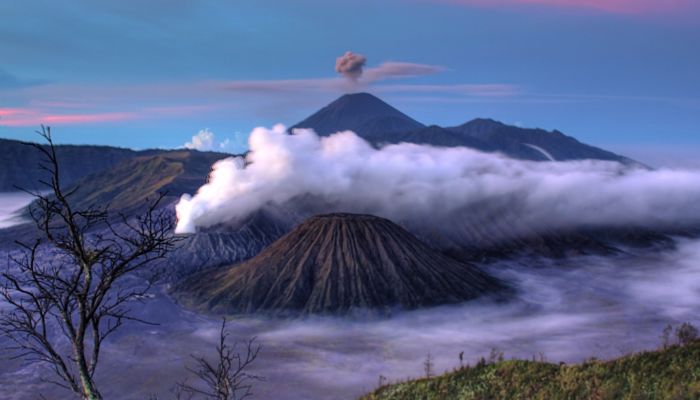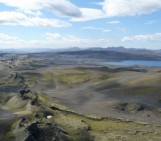
I was taking a plane trip home recently. To kill the time I got talking with the person sitting next to me and naturally one of their first questions was to ask me what I did for a living. To avoid a complicated discussion about the nuances of my research I summarised – ‘I am a volcanic meteorologist’. They were interested and wanted to know all about how volcanoes affect the weather, my opinion on ‘that Icelandic eruption’ and told me some slightly left-field opinions on climate change. It was an interesting chat and it got me thinking, volcanoes seem to have several well known impacts on weather but can weather have an impact on volcanoes?
At first it appears quite strange that something seemingly so solid can be altered by atmospheric processes. But in the case of mudflows this is exactly what can happen – rain mixing with soil causing soft wet mud to slide down a hill. In the case of volcanoes, a lahar can form, a mudflow consisting of volcanic debris with the consistency of wet concrete which cascades down the slopes of a volcano.
Water has also been known to trigger rockfalls by getting into the cracks between rocks and weakening them. This same erosion process can erode scree from the summit of a volcano.
Lava domes (a roughly circular shaped mound created from the slow extrusion of lava from a volcano) are known to grow in the absence of rainfall. When it rains water seeps into the cracks between rocks in the lava dome. The lava dome is very hot so rain instantly vapourises. Hence a large rain rate is needed to get further inside cracks in the rocks. Once deep inside, the rainwater vapourises into high pressure steam as it encounters temperatures in excess of 300 C. This destabilises the lava dome and sometimes leads to a collapse.
A collapsing lava dome creates a pyroclastic flow, a high-density mix of volcanic rocks and gas travelling down the slopes of a volcano at high speed and destroying almost everything it its path. A 2001 lava dome collapse is thought to have been triggered by rainfall.
Excessive rainfall can and does impact volcanoes. Having said this hurricanes and other large storms, having a rainfall rate needed to cause water to seep into the lava dome of a volcano are mostly found in the tropics.
Do you know of any other cases of weather affecting volcanoes? The author would be interested to know – please post your suggestions in the comments.


DEBORAH DAVIS
The East side of the Big Island of Hawaii is one of the highest rainfall areas in the World. This is the area known as Puna. Upper Puna is home to Kilauea Volcanoe National Park and lower Puna is home to the lower East Rift Zone where recent fissures have opened up and lava is now shooting over 200 feet into the air and flows are covering homes and roads on it’s way to the sea. Do you think that the constant rains contributed to the weakening of the underground lava tubes causing a break and a collapse of the lava lake in the main caldera and suspended activity at Puu Oo vent? Was rain the cause of the collapse and earthquakes or did the Earth’s plates move and cause the earthquakes which caused the eruption? Also, is the barometric pressure changing because of the gasses? My daughter is asthmatic and has a connective tissue disorder and is suffering with breathing the VOG and having pressure headaches.
Slawek
silly question really: but can low atmospheric pressure (or rapid pressure changes) somewhat “help” to trigger volcano’s eruption?
Dasaraden Mauree
There is currently no evidence pointing in this direction.
Elijah
Rain would only slightly increase the likelihood. The pressure of the steam produced is proportional to the temperature of the lava surface. High pressures may increase the likelihood of a collapse by pushing the lava in a different direction and through the underground lava tubes to a point of structural weakness.
A severely heavy rain (like that of catastrophic climate changes) might increase the likelihood of a collapse drastically which may release other kinds of gasses and debris into the air and cause more rain to fall. I Googled this because I was wondering if volcanic activity was influenced by other types of weather and could decrease cloud formation, decreasing the effects of atmospheric CO2 on cloud formation and global temperatures. A kind of balancing effect I imagined, but I still feel like the equilibrium would be offset by a degree which is definitely not ideal.
Mackenzie
Hi, I am Mackenzie, i’m 15. Are volcanoes more likely to erupt in cold weather? I have this theory, (probably a dumb theory) that Yellowstone’s super volcano hasn’t erupted because of global warming. From my research, it seems like the 3 times that Yellowstone has erupted was around ice age periods. That makes me wonder if Yellowstone hasn’t erupted because of global warming.
Steven Brill
I thought I saw a center of a low pressure, just barely to the west of the volcanic eruption near Toga, when it occurred.
Cecil Gonzales
Well right now June 11, 2023 in Philippines theres impending eruption of Mayon Volcano, Taal and Mt.Camlaon. But just this weekend there’s Tropical Cyclone Typhoon so heavy rains poured out starting June 10 for longer hours continously. Does this typhoon can slowdown or trigger the eruption in any of these volcanoes mentioned mostly Mayon Volcano?